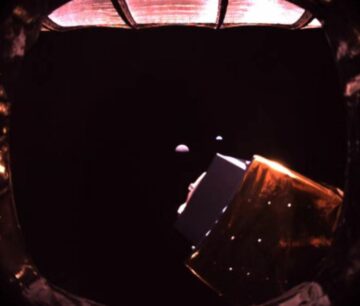
National security space leaders talk the talk on embracing commercial innovation, but are they walking the walk?
In speeches and interviews, U.S. Space Force Space Systems Command leaders frequently cite their mantra, “Exploit what we have, buy what we can and build only what we must.”
National Reconnaissance Office leaders have a similar saying, “Buy what we can, build what we must.”
After years of these pronouncements, current and former government officials are underscoring the gap between words and actions.
Exactly how much of the government’s estimated $70 billion in national security space funding is flowing to the entrepreneurial space sector? It’s hard to say.
At the 39th Space Symposium Peter Beshar, U.S. Air Force general counsel, said the Space Force allocated approximately $2.5 billion, or 9.6 percent of its 2023 budget to the commercial space industry. Much of that money goes toward satellite communications and launch, services overwhelmingly provided by the private sector.
NRO officials declined to comment on commercial spending, since the intelligence agency’s budget is classified.
Former government officials, some of whom spoke with SpaceNews on background, said U.S. national security space agencies overall could be devoting as little as 2 percent or as much as 5 percent of their combined budgets to commercial programs.
In spite of some high-profile contract awards and multiple organizations established in recent years to tap into commercial innovation, “there’s definitely a mismatch between what people are doing and what they’re saying,” said a former DARPA program manager.
“If they were telling the truth, they would say ‘buy what we’re forced to and build anything we can get away with,’” said a former national security space leader.
The problem is “bigger than you realize,” said a second former national security space leader. “There are a lot of sole-source contracts going to the old guard to develop things that can be done and are being done by other companies.”
A third former national security space leader was even more blunt, criticizing the Defense Department’s space procurement fiefdoms for publicly embracing innovation without taking signicant action to back it up. “It’s innovation theater.”
Good news, bad news
To better understand the gap between words and actions, SpaceNews spoke with dozens of current and former government officials, industry executives, investors and entrepreneurs. Many asked not to be identified. People speaking on the record, at conferences for example, were more measured in their assessment.
“It’s a little bit of a good news, bad news story,” Tom Gillespie, managing partner for In-Q-Tel, the intelligence community’s investment arm, said in October at the MilSat Symposium in Mountain View, California. “The good news is the government is much more interested in engaging with young startup companies compared with a few years ago. What’s missing is the next step: meaningful contracts on an ongoing basis, more of a partnership between the government and these companies, where it’s not just a one-off or [Small Business Innovation Research] dollars, it’s a demand signal that says, ‘Here’s what we need and here’s how big the opportunity is.’”
If instead of providing that information, agencies declare their interest in commercial products or services without following through, “they give the private sector false signals that will cause them to modify their business plans,” said a former U.S. Air Force officer. “When you know there’s no pot of gold at the end of the rainbow, it’s actively harmful to pretend there is. That causes disruptions in the market and causes companies to go bankrupt.”
Changing threats
So, why are military space leaders proclaiming the value of commercial innovation? Some of it is heartfelt, said Fred Kennedy, a former Air Force colonel who led the Defense Advanced Research Projects Agency’s space-heavy Tactical Technology Office before serving as the Space Development Agency’s inaugural director in 2019 and leaving government service for stints at commercial space ventures Astra Space and Momentus.
“If we were having this discussion in 2014 and someone said, ‘Should we rely on commercial space to provide for critical defense needs?’ They’d be laughed out of most offices,” said Kennedy, now CEO of Dark Fission Space Systems, a startup developing nuclear thermal rocket engines. “Now, people can’t do that. They have to admit that the capability, if not there, is at least almost there.”
And through frequent upgrades, like the Space Development Agency’s two-year tranches, “you could move the technology exactly where you want it to go, iPhone style,” Kennedy said.
Yesterday’s Technology
What’s more, technology is changing rapidly as are potential threats to U.S. space systems. In mid-February, for instance, White House officials confirmed reports of a new Russian anti-satellite weapon.
“We can’t afford to be buying yesterday’s stuff because our peer adversaries are buying today’s stuff,” said Steve “Bucky” Butow, Defense Innovation Unit space portfolio director. “From an industrial policy standpoint, we have to relearn that commercial is the best path for us to reduce cost, increase scale and move with speed.”
Butow pointed to the 2022 National Defense Strategy, which called for “an order of magnitude increase in its adoption of commercial technologies.”
A preference for purchasing systems commercially rather than paying contractors to build them has been “national bipartisan policy and congressional intent for about the last two decades,” said Kevin O’Connell, who led the Commerce Department’s Office of Space Commerce from its 2019 inception until the January 2021 inauguration of the Biden administration.
The commercial item preference often is not followed, though, in the military space sector.
“There’s enough wiggle room in the law and regulations” to get around it, said William Greenwalt, senior fellow at the American Enterprise Institute and former deputy undersecretary of defense for industrial policy.
Wrong incentives
One problem is the unclear wording of the Federal Acquisition Regulation for acquiring commercial products and services, known as FAR Part 12. The first part of the regulation “says we should be maximizing the procurement of commercial stuff. That’s right on the mark,” Butow said. “But the rest is nebulous. The phraseology is problematic.”
Plus, in the current system the incentives are wrong.
“It’s a lot of work to do a competitive request for proposals,” said a former Pentagon official. “It’s much easier for a contracting officer, who’s told by the program director to write a sole-source justification, to do it.”
In fact, contracting officers risk angering program directors or auditors if they don’t comply. For auditors, it’s easier to determine the appropriate cost of items if they have all the data they need in a familiar format.
“Of course, the big companies do this,” Greenwalt said. “And commercial companies are all over the place. If it’s hard for the auditors, the auditors come down on the acquisition workforce to justify the use of commercial when they don’t necessarily have this type of costing” system.
Budget hurdles
Another problem is the Defense Department’s Planning, Programming, Budgeting and Execution (PPBE) process. Under the PPBE process, established in 1961 by Defense Secretary Robert McNamara, it takes three years to get money for a program.
“Three years is like an eternity in 2024,” Butow said. Technology is evolving rapidly and “there are companies that can’t even tell you what they’re going to be building in three years.”
“We are in a race for technological superiority,” Air Force Secretary Frank Kendall said at a Feb. 8 Rand webinar on PPBE reform. “We’ve got to be responsive, competitive agile” but “we’re living within a system that isn’t any of those things.”
U.S. Space Force Col. Richard Kniseley, head of Space Systems Command’s recently established Commercial Space Office, called the PPBE process “system-focused instead of being overall capability-focused.” For instance, if the GPS program office wanted to spend money on alternative position, navigation and timing technologies, it would be “very hard to pivot those dollars,” he added.
Signs of change
Change may be coming, though. The Commission on PPBE Reform, established by Congress in 2022, issued a report March 6 that recommends ways to make the budget process more flexible. For instance, combining budget line items in broader areas would give acquisition officers greater flexibility while preserving congressional oversight, Robert Hale, Center for Strategic and International Studies senior fellow and former Defense Department comptroller, said during the Rand webinar. Another priority the commission cited was flexibility in reprogramming appropriated funds.
In addition, military space leaders like Gen. Chance Saltzman, chief of space operations, and Frank Calvelli, Air Force assistant secretary for space acquisition and integration, are waging high-profile campaigns to encourage the adoption of more commercial technology.
The Defense Department recently unveiled its first-ever strategy to integrate commercial space technologies into its national security architecture. And on April 10, the Space Force released its own blueprint for working with industry.
“The Space Force is committed to enhancing its partnerships with the commercial space industry, our allies and other international partners,” Saltzman said at the Space Symposium.
Essential Backup
The strategy documents and rhetoric are important because they provide cover for Space Force personnel seeking to adopt commercial technology.
“The issue, though, is the first time a contracting officer is called to the carpet by the auditors, where is Saltzman and where is Calvelli then,” Greenwalt asked. “Are they going to back up their contracting officers who need to make decisions, or are they going to let them hang out there in the wind? If they let them hang in the wind, then you will get no adoption. The U.S. government will continue to go on and this will all be worthless rhetoric.”
Contract awards
National security space leaders say their commitment to commercial space is clear from recent contract awards.
In 2022, the NRO awarded commercial imagery contracts to BlackSky, Maxar Technologies and Planet worth $4 billion over a decade. The NRO continues to evaluate commercial suppliers of synthetic aperture radar, radio frequency monitoring, hyperspectral and thermal imagery.
In addition, the NRO buys commercial “cloud services, launch services, spacecraft and components,” said Pete Muend, director of the NRO Commercial Systems Program Office. “Our partnerships with industry are integral to our mission and key to our success.”
Meanwhile, the National Geospatial-Intelligence Agency is looking for commercial satellite imagery and data analytics to support global monitoring for Luno A, a program with a potential value of $290 million.
The Space Force spends more than $850 million a year on commercial satellite communications and buys all of its launch services commercially.
In partnership with DIU, Space Force program executives are seeking funding for strategic fund increase, STRATFI awards. The STRAFI program provides small businesses with $3 million to $15 million to help bridge the valley of death between technology development and commercial adoption.
Inherently government
Still, some military space programs are so critical to national security they can’t be outsourced.
“We’ve spent a fair amount of time thinking about what is inherently government,” Claire Leon, director of the Space Systems Command Space Systems Integration Office, said at the MilSat Symposium late last year. “Classified capabilities, strategic missile warning and anything nuclear are things that we’re not going to buy commercially.”
In addition, some products and services the government needs have few commercial applications.
Even in those cases, commercial technology could help fulfill missions, said Charles Beames, a retired U.S. Air Force colonel, former Pentagon principal director of space and intelligence systems, and chairman of the SmallSat Alliance, a trade association.
“Every single mission that is currently being done by the Space Force could be done with some amalgamation of commercial off-the-shelf and/or existing government off-the-shelf technology,” Beames said. “Every mission can be done that way now with small satellites. You literally do not need the school bus sized satellites anymore for any of these missions.”
This article first appeared in the April 2024 issue of SpaceNews magazine.
- SEO Powered Content & PR Distribution. Get Amplified Today.
- PlatoData.Network Vertical Generative Ai. Empower Yourself. Access Here.
- PlatoAiStream. Web3 Intelligence. Knowledge Amplified. Access Here.
- PlatoESG. Carbon, CleanTech, Energy, Environment, Solar, Waste Management. Access Here.
- PlatoHealth. Biotech and Clinical Trials Intelligence. Access Here.
- Source: https://spacenews.com/innovation-theater-fills-gap-between-words-and-action/
- :has
- :is
- :not
- :where
- $2.5 billion
- $3
- $UP
- 01
- 10
- 12
- 2%
- 2014
- 2019
- 2021
- 2022
- 2023
- 2024
- 5
- 6
- 8
- 9
- a
- About
- acquiring
- acquisition
- Action
- actions
- actively
- added
- addition
- administration
- admit
- adopt
- Adoption
- advanced
- afford
- agencies
- agency
- ago
- AIR
- Air Force
- All
- Alliance
- allocated
- almost
- alternative
- American
- amount
- an
- analytics
- and
- Another
- any
- anymore
- anything
- appeared
- applications
- appropriate
- approximately
- April
- April 2024
- architecture
- ARE
- areas
- ARM
- around
- article
- AS
- asked
- assessment
- Assistant
- Association
- Astra
- At
- auditors
- awarded
- awards
- away
- back
- background
- Bad
- bankrupt
- basis
- BE
- because
- been
- before
- being
- BEST
- Better
- between
- biden
- Biden Administration
- Big
- Billion
- bipartisan
- Bit
- BRIDGE
- broader
- budget
- budgeting
- Budgets
- build
- Building
- bus
- business
- business plans
- businesses
- but
- buy
- Buying
- Buys
- by
- california
- called
- Campaigns
- CAN
- Can Get
- capabilities
- capability
- carpet
- cases
- Cause
- causes
- Center
- ceo
- chairman
- Chance
- changing
- Charles
- chief
- cited
- classified
- clear
- combined
- combining
- come
- coming
- command
- comment
- Commerce
- commercial
- commercially
- commission
- commitment
- committed
- Communications
- Companies
- compared
- competitive
- comply
- components
- Comptroller
- conferences
- CONFIRMED
- Congress
- Congressional
- continue
- continues
- contract
- contracting
- contractors
- contracts
- Cost
- could
- counsel
- course
- cover
- critical
- Current
- Currently
- Dark
- darpa
- data
- Data Analytics
- Death
- decade
- decades
- decisions
- Defense
- Defense Department
- definitely
- Demand
- Department
- deputy
- Determine
- develop
- developing
- Development
- Director
- Directors
- discussion
- disruptions
- do
- documents
- doing
- dollars
- done
- Dont
- down
- dozens
- during
- easier
- embracing
- encourage
- end
- engaging
- Engines
- enhancing
- enough
- Enterprise
- entrepreneurial
- entrepreneurs
- established
- estimated
- evaluate
- Even
- evolving
- exactly
- example
- execution
- executives
- existing
- fact
- fair
- false
- familiar
- far
- Feb
- Federal
- fellow
- few
- fills
- First
- first time
- first-ever
- Flexibility
- flexible
- Flowing
- followed
- following
- For
- Force
- forced
- format
- Former
- frank
- Frank Kendall
- Frequency
- frequent
- frequently
- from
- Fulfill
- fund
- funding
- funds
- gap
- Gen
- General
- get
- Give
- Global
- Go
- Goes
- going
- Gold
- good
- got
- Government
- Government Officials
- gps
- greater
- Guard
- Hale
- Hang
- Hard
- harmful
- Have
- having
- he
- head
- help
- high-profile
- House
- How
- HTTPS
- identified
- if
- important
- in
- Inaugural
- inauguration
- Incentives
- inception
- Increase
- industrial
- industry
- information
- inherently
- Innovation
- instance
- instead
- Institute
- integral
- integrate
- integration
- Intelligence
- intent
- interest
- interested
- International
- Interviews
- into
- investment
- Investors
- iPhone
- issue
- Issued
- IT
- items
- ITS
- January
- January 2021
- jpg
- just
- Kendall
- Key
- Know
- known
- Last
- Last Year
- Late
- laughed
- launch
- Law
- leader
- leaders
- least
- leaving
- Led
- let
- like
- Line
- literally
- little
- living
- looking
- Lot
- Luno
- magazine
- magnitude
- magnitude increase
- make
- manager
- managing
- managing partner
- Mantra
- many
- March
- mark
- Market
- maximizing
- May..
- meaningful
- measured
- Military
- million
- mismatch
- missing
- Mission
- missions
- modify
- money
- monitoring
- more
- most
- Mountain
- move
- much
- multiple
- must
- National
- national security
- Navigation
- necessarily
- Need
- needs
- New
- news
- next
- no
- now
- nuclear
- october
- of
- Office
- Officer
- officers
- offices
- official
- officials
- often
- Old
- on
- ongoing
- only
- Operations
- Opportunity
- or
- order
- organizations
- Other
- our
- out
- over
- overall
- Oversight
- overwhelmingly
- own
- part
- partner
- partners
- Partnership
- partnerships
- path
- paying
- peer
- pentagon
- People
- percent
- Personnel
- Peter
- Pivot
- Place
- planet
- planning
- plans
- plato
- Plato Data Intelligence
- PlatoData
- policy
- portfolio
- position
- pot
- potential
- preserving
- Principal
- priority
- private
- private sector
- Problem
- process
- procurement
- Products
- Products and Services
- Program
- Programming
- Programs
- projects
- Proposals
- provide
- provided
- provides
- providing
- publicly
- purchasing
- Race
- radar
- Radio
- rand
- rapidly
- rather
- realize
- recent
- recently
- recommends
- record
- reduce
- reform
- Regulation
- rely
- report
- Reports
- request
- research
- responsive
- REST
- Richard
- right
- Risk
- ROBERT
- rocket
- Room
- russian
- s
- Said
- satellite
- satellite imagery
- satellites
- say
- saying
- says
- Scale
- School
- Second
- secretary
- sector
- security
- seeking
- senior
- service
- Services
- serving
- should
- Signal
- signals
- similar
- since
- single
- sized
- small
- small business
- small businesses
- So
- some
- Someone
- Space
- Space Force
- space industry
- spacecraft
- SpaceNews
- speaking
- speeches
- speed
- spend
- Spending
- spends
- spent
- Spite
- standpoint
- startup
- startup companies
- Step
- Steve
- Story
- Strategic
- Strategy
- studies
- stuff
- style
- success
- superiority
- suppliers
- support
- Symposium
- synthetic
- system
- Systems
- tactical
- takes
- taking
- Talk
- Tap
- technological
- Technologies
- Technology
- Technology Development
- tell
- telling
- than
- that
- The
- the Law
- Theater
- their
- Them
- then
- There.
- thermal
- These
- they
- things
- Thinking
- Third
- this
- those
- though?
- threats
- three
- Through
- time
- timing
- to
- today’s
- told
- tom
- toward
- trade
- truth
- two
- type
- u.s.
- U.S. Air Force
- U.S. government
- U.S. Space Force
- unclear
- under
- understand
- unit
- until
- upgrades
- us
- use
- Valley
- value
- Ventures
- View
- walk
- walking
- want
- wanted
- warning
- was
- Way..
- ways
- we
- webinar
- were
- What
- What is
- when
- which
- while
- white
- White House
- WHO
- whom
- why
- will
- william
- wind
- with
- within
- without
- wording
- words
- Work
- Workforce
- working
- worth
- would
- would give
- write
- Wrong
- year
- years
- you
- young
- zephyrnet








